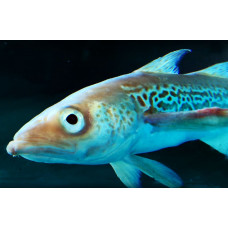Latin name
Gadus chalcogrammus
Other names
Walleye pollock
Identification
Alaska pollack have very large eyes and a very short tendril under the lower lip. The lateral line is continuous to about the posterior end of the base of the first dorsal fin; it is interrupted at the top of the body. There are pores in the lateral line on the head. The Alaska pollack has well-developed tympanic muscles, which the fish uses, like many other gadus, to produce sounds during courtship.
Features of fish fins
Have three dorsal fins. The pelvic fins are in front of the pectoral fins. Dorsal spines (total): 0; Dorsal soft rays (total): 38-48; Anal spines: 0; Anal soft rays: 33-42. Dorsal fins widely spread. The pelvic fins have a slightly elongated filament.
Fish colouring
The colouration is mottled, ranging from olive green to brown on the back, becoming silvery on the sides and pale on the belly, often with mottled patterns or spots. This colouration makes it difficult for predators to spot them on the sandy seabed.
Distribution
The main habitats are the coastal areas of the North Pacific Ocean, especially the waters off Alaska (eastern Bering Sea, Gulf of Alaska, Aleutian Islands) and off Russia, Japan and Korea (western Bering Sea and Sea of Okhotsk). The highest concentrations of Alaska pollock are found in the eastern Bering Sea.
Habitat
It lives in cold waters (2 to 9°C) and prefers depths of 200 to 300 metres, although it can migrate to depths of 500 to 700 metres and deeper.
Size
The maximum length is 91 cm and the mass is 5 kg. The maximum life expectancy is 15 years.
Behavior
These fish exhibit a constant vertical migration, following the seasonal movement of their food. Although they move vertically throughout the day, their average depth of occurrence varies with the season. In August, when food is abundant near the surface, the fish can be found at shallower depths. In November they are found at deeper depths with their planktonic food source.
Food and feeding habits
It feeds mainly on planktonic crustaceans. As it grows, it begins to feed on larger prey, namely small fish (capelin, rainbow smelt) and squid. There have been cases of cannibalism - eating larvae and juveniles of their own species.
Reproduction
Egg-laying, both sexes separate.
During spawning it approaches the shore and swims into shallow water 50-100 m deep. Spawning schools are very dense. Spawning itself begins at different times in different parts of the Pacific. For example, spawning in the Bering Sea occurs in spring and summer (March to September), off the coast of Korea - in winter and spring (November to March), off Kamchatka - in spring. Females can lay eggs at sub-zero temperatures (-1.8°C).
It reaches sexual maturity at the age of 3-4 years and reaches its weight limit, which also varies in different areas of its habitat (from 2.5 to 5 kg).
Fishing
Approximately 3 million metric tonnes (3,000,000 long tonnes; 3,300,000 short tonnes) are caught annually in the North Pacific, from Alaska to northern Japan. It is the second most important fish species in the world in terms of total catch, after Peruvian anchoveta.
Relationship with a person
Alaska pollock is said to be "the largest surviving source of delicious fish in the world". Compared to other types of cod and pollock, Alaska pollock has a milder flavour, whiter colour and lower oil content.
| Classification | |
| Phylum | Chordata |
| Class | Actinopterygii |
| Squad | Gadiformes |
| Family | Gadidae |
| Genus | Gadus |
| Species | G. chalcogrammus |
| Features | |
| Conservation status | Near Threatened |
| Habitat | Pelagic |
| Life span, years | 15 |
| Maximum body weight, kg | 5 |
| Maximum length, cm | 91 |
| Sailing speed, m/s | No information |
| Threat to people | Edible |
| Way of eating | Predator |
Alaska pollock
Tags: alaska pollock



